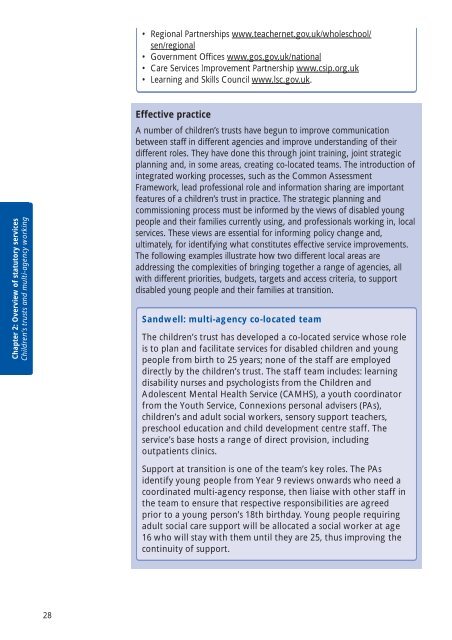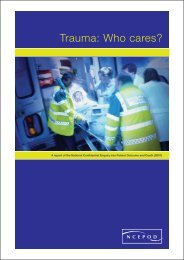A Transition Guide for All Services - Transition Information Network
A Transition Guide for All Services - Transition Information Network
A Transition Guide for All Services - Transition Information Network
- No tags were found...
Create successful ePaper yourself
Turn your PDF publications into a flip-book with our unique Google optimized e-Paper software.
• Regional Partnerships www.teachernet.gov.uk/wholeschool/sen/regional• Government Offices www.gos.gov.uk/national• Care <strong>Services</strong> Improvement Partnership www.csip.org.uk• Learning and Skills Council www.lsc.gov.uk.Chapter 2: Overview of statutory servicesChildren’s trusts and multi-agency workingEffective practiceA number of children’s trusts have begun to improve communicationbetween staff in different agencies and improve understanding of theirdifferent roles. They have done this through joint training, joint strategicplanning and, in some areas, creating co-located teams. The introduction ofintegrated working processes, such as the Common AssessmentFramework, lead professional role and in<strong>for</strong>mation sharing are importantfeatures of a children’s trust in practice. The strategic planning andcommissioning process must be in<strong>for</strong>med by the views of disabled youngpeople and their families currently using, and professionals working in, localservices. These views are essential <strong>for</strong> in<strong>for</strong>ming policy change and,ultimately, <strong>for</strong> identifying what constitutes effective service improvements.The following examples illustrate how two different local areas areaddressing the complexities of bringing together a range of agencies, allwith different priorities, budgets, targets and access criteria, to supportdisabled young people and their families at transition.Sandwell: multi-agency co-located teamThe children’s trust has developed a co-located service whose roleis to plan and facilitate services <strong>for</strong> disabled children and youngpeople from birth to 25 years; none of the staff are employeddirectly by the children’s trust. The staff team includes: learningdisability nurses and psychologists from the Children andAdolescent Mental Health Service (CAMHS), a youth coordinatorfrom the Youth Service, Connexions personal advisers (PAs),children’s and adult social workers, sensory support teachers,preschool education and child development centre staff. Theservice’s base hosts a range of direct provision, includingoutpatients clinics.Support at transition is one of the team’s key roles. The PAsidentify young people from Year 9 reviews onwards who need acoordinated multi-agency response, then liaise with other staff inthe team to ensure that respective responsibilities are agreedprior to a young person’s 18th birthday. Young people requiringadult social care support will be allocated a social worker at age16 who will stay with them until they are 25, thus improving thecontinuity of support.28
















